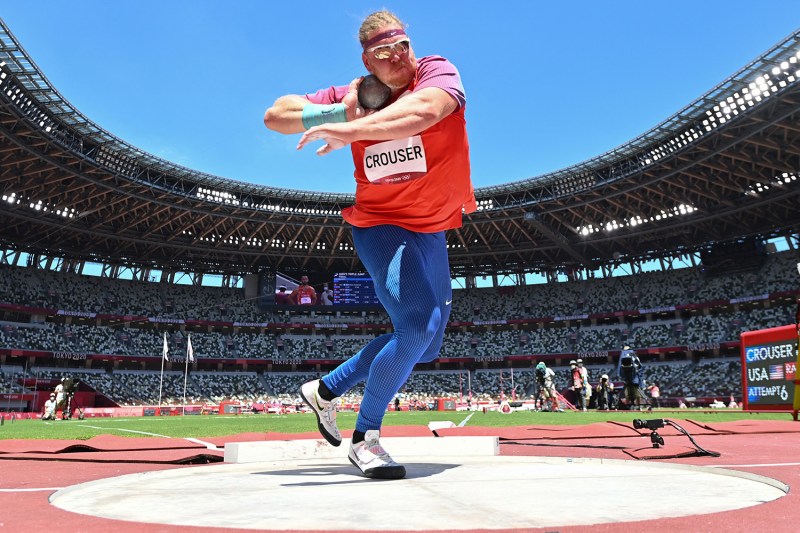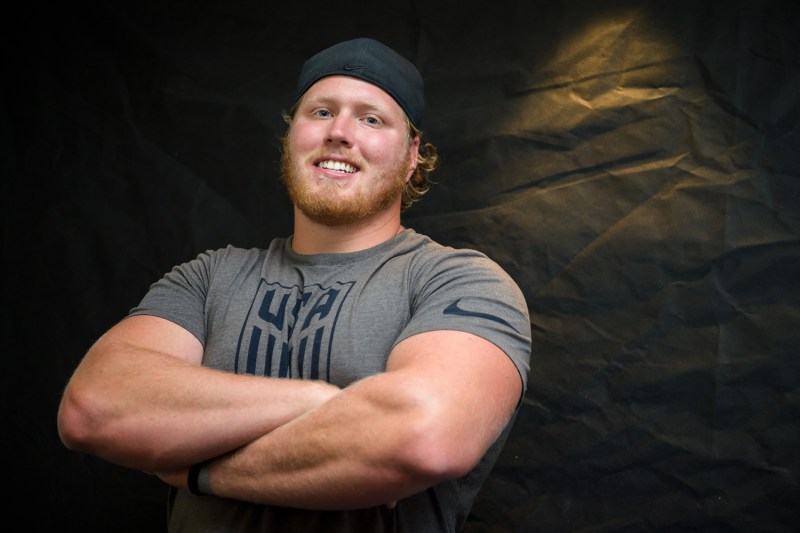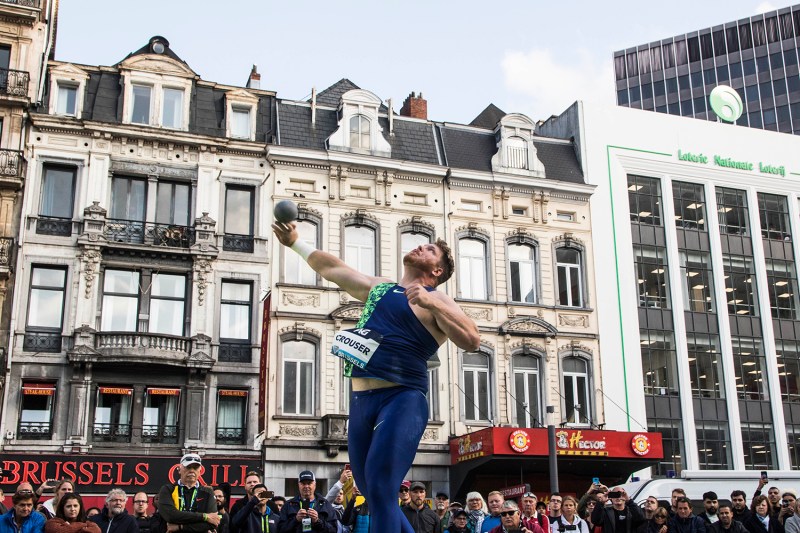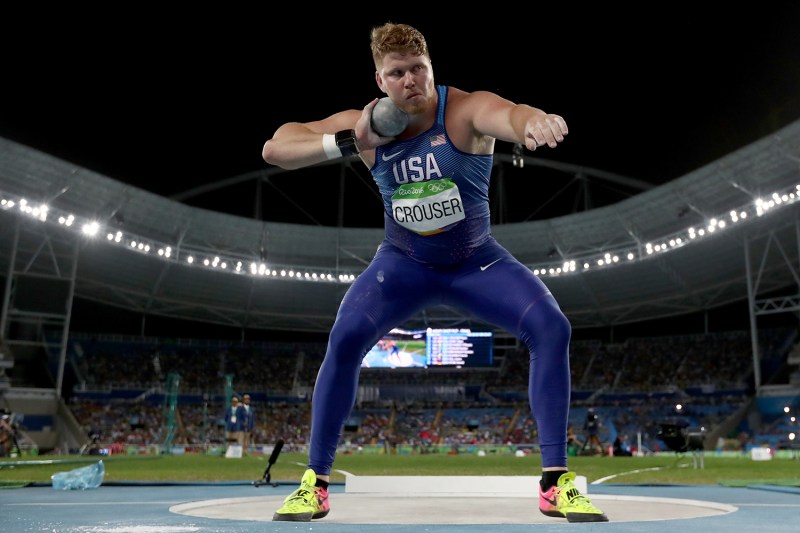
On January 24, Larry Eder, a 38-year veteran journalist for track and field, was on his couch at his home in Wisconsin when he watched the indoor shot put world record broken — or was it? The ESPN announcers, only a few minutes into the broadcast, were frantically flipping through notes, unsure, and the rubber-covered 16-pound ball lay there on the turf like a mushroom, cameras zoomed in on as if it could offer a hint. “If you break the record and no one can measure it, did you really break it?” Eder asks philosophically.
It turns out the indoor world record was broken, and Ryan Crouser, a 28-year-old pro living in Fayetteville, Ark., did it with a 74-foot, 10.5-inch throw, flying over the 32-year-old mark by more than six inches. Crouser is a beast of a man, a 2016 Olympic gold medalist and third-generation thrower whose genetics make him as similar to you as a trout is to a softball. Standing six-foot-seven and walking around at 320 pounds, he is a different species. “I don’t want to use the word ‘freak,’” Eder says. “But he’s a physical genius.”
Related Guides
- Can You Watch All of the Tokyo Olympics on Peacock?
- Is Peacock Free? Everything You Need to Know Before the Olympics
But Crouser, a Portland native, is not just strong — if it were up to raw strength, he wouldn’t be anywhere near the pinnacle of his sport. No, the reason Crouser is arguably the best in the world is because of his flexibility and technique. For the former, we’re not talking about spreading into splits. Rather, it’s generating power through a range of motion. It’s medicine balls launched into space. And for technique, we’re talking about an athletic version of Will Hunting.

Crouser can tell you in a tone normally reserved for the weather report that in order for him to break the outdoor record of 23.12 meters, or just over 75 feet, 10 inches, his body must generate 14.5 meters or — and here he mumbles a quick conversion to the imperial system — 33 miles per hour on release. On his “perfect” indoor throw, he’ll explain that his technique was not perfect, with some positives and other areas in which he needs to go back to the drawing board.
“You can try your best to throw hard in practice,” he tells The Manual, “but you can’t really simulate that same adrenaline and intensity that you have in the meet.”
It’s within the context of the meet that Crouser’s best comes out. Analysts of the sport cite one of his best performances as a match in which he lost. At the 2019 World Championships, held in Doha, Qatar, he went back and forth with two other men. “It was that perfect storm,” Eder, who watched from the media scrum, says. “Three amazing guys who knew how to compete and draw the best out in each other. And each throw got better.”
It’s the head-to-head battle against the other throwers. And it’s the roar of the 80,000-person crowd, the pulse of sounds as events take place concurrently in the infield and around the track, a Noah’s Ark of body types, group by group specializing in singular aspects of human performance. “It takes your breath away,” Crouser says. “You feel like you can compete at a whole new level that you didn’t know was possible. It’s a combination of the preparation and the magic that’s in the air.”

2020 was supposed to be redemption, a return to the Olympic podium and back-to-back medals. It would be the payoff from the grueling weeks of Olympic lifting, squatting, bench pressing, plyometrics, sprinting, and four to five days of dedicated throwing practice each week. But 2020 obviously didn’t play out that way. Without a laugh, he’ll tell you how in March, when the University of Arkansas closed his training facilities, he walked the aisles of Home Depot the next morning purchasing lumber to build his own throwing station. For the next five months, he threw behind the grade school, mortaring solid steel balls into the narrow space between tree line and baseball outfield.
At the silent, near-crowdless meet where he broke the indoor world record, does he miss the way it used to be? “I’m still just excited about having a chance to compete after having to train behind an elementary school,” Crouser says.
This is objectively funny, but Crouser doesn’t laugh. It’s one more point along the way.
“You spend so much time building it up in your head and you spend thousands of hours working toward it,” he says. “And then when you finally get it, the next day, you expect your life to change in this monumental way. You still wake up in the same bed. Now what?”
After the audience roar is only a phantom echo, the medals lose their glint, and marks become numbers that people have to Google to confirm, it’s the points along the way that matter the most.

Crouser was fortunate to learn this early, achieving a four-year goal of breaking the national high school record his senior year. Later, it was the gold in Rio. “I feel like I’ve gotten better putting it into perspective,” he says. “It’s the journey along the way where the real value is.”
At the American Track League’s final event of the year on February 21 and broadcast on ESPN, Crouser will again compete in the shot put, a newly minted world record-holder looking to beat his own best as well as the men around him. “I think he’ll be over 75 feet, two inches,” Eder, ever the handicapper, says, predicting another record.
But Crouser looks at it differently.
On his bathroom mirror, he writes his goals. Yes, the indoor world record was on there, as is one centimeter over the current outdoor world record, which he’ll undoubtedly target this summer. But more and more, his goals are shifting from the concrete of distances and medals to the more ambiguous.

The two he looks at, that he thinks about most of late, now that another record has fallen:
“Be present in the moment,” and, “Enjoy the process.”
Postscript: Crouser notched a few more milestones in his standout 2021 season, breaking the outdoor shot put world record in June with a throw of 76 feet, 8.25 inches, which bested the previous mark by more than a foot, or roughly the equivalent of overshooting the moon and landing on Mars. At the Tokyo Games on August 5, 2021, he broke his own Olympic record for the event, set in 2016, in every one of his six attempts, earning his second gold medal in as many appearances.
But, again, it’s all about the memories along the way.
Crouser’s grandfather, the first of his lineage to take up throwing, passed away a month before the youngest would depart for Tokyo. After his sixth and final throw and an Olympic gold secured, the third-generation thrower held up a hand-written sign to the cameras. It read: “Grandpa, we did it.”



